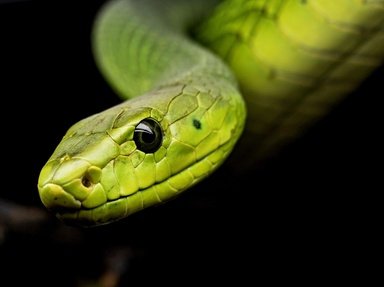Quiz Answer Key and Fun Facts
1. The snakes of the Elapidae family are native to the tropical and subtropical regions of the world. What continent or geographical region is home to the largest number of elapid genera?
2. The elapids are one of three snake families whose members are all (or nearly all) venomous. Which of these is NOT true of elapid snakes?
3. Endemic to Asia and Africa, cobras are greatly feared throughout their range for their venomous bite. What other defense mechanism do some species of cobra - such as the rinkhals in the photo - possess?
4. The longest venomous snake, the king cobra of South and Southeast Asia is a fearsome creature. Which of these facts about its diet is true?
5. This scary-looking creature is a denizen of the semiarid regions of central Australia. It also boasts the most toxic venom of any snake. By what name is it known?
6. No snake hall of infamy would be complete without a mention of the eastern brown snake, often encountered in urban areas of eastern Australia. Which small, prolific mammal - not native to the country - is its main prey?
7. The common krait is one of the "Big Four", India's four deadliest snake species. It also makes a brief appearance (though inaccurately described) in the short story "Rikki-Tikki-Tavi" by what turn-of-the-20th-century English author?
8. The genera Micrurus and Micruroides - commonly known as coral snakes - comprise the only terrestrial elapid species native to the New World. These brightly-coloured snakes possess a potent venom, but are not as dangerous to humans as other species because of their short fangs and reclusive nature.
9. In terms of bad reputation, no snake can compete with the black mamba, Africa's most feared snake. What rather ominous object is the shape of its head often compared to?
10. Sea snakes are among the most venomous members of the elapid family. Found in the tropical waters of the Indian and Pacific Oceans, in which of these marginal seas would these snakes be likely to be encountered?
Source: Author
LadyNym
This quiz was reviewed by FunTrivia editor
rossian before going online.
Any errors found in FunTrivia content are routinely corrected through our feedback system.
